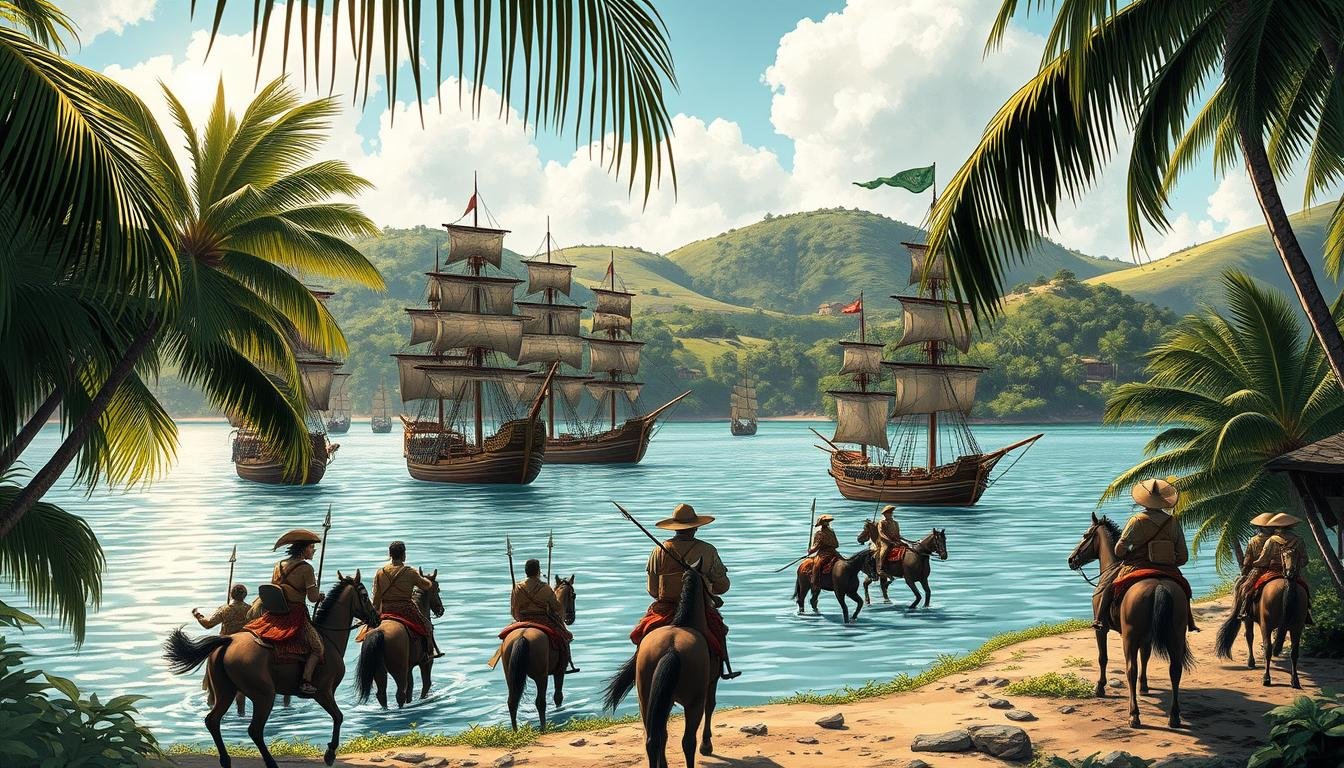The history of Bohol’s alliance with Miguel López de Legazpi and the Spanish Empire is a fascinating chapter in Philippine development. This partnership was not just a diplomatic agreement but a strategic move influenced by complex maritime and political dynamics.
During this period, alliances were often forged through shared goals and mutual interests. The Spanish sought to expand their influence, while local leaders aimed to strengthen their power and protect their communities. These interactions laid the groundwork for significant changes in the region’s state systems.
This article explores how these historical events shaped Bohol’s identity and its relationship with Spain. By examining the strategy behind these alliances, we gain insight into the broader impact on Philippine history and culture.
Key Takeaways
- Bohol’s alliance with Legazpi was a strategic move influenced by maritime and political factors.
- These alliances played a key role in shaping the region’s state systems and power dynamics.
- The partnership highlights the complex interactions between local leaders and Spanish colonizers.
- Understanding these events provides insight into Philippine history and cultural development.
- The alliance was a turning point in Bohol’s relationship with Spain.
Introduction: Unfolding Bohol’s Strategic Past
Bohol’s strategic past reveals a complex interplay of trade and conflict. During the colonial period, the island emerged as a key player in regional dynamics. Its location and resources made it a focal point for economic and political forces.
Over the centuries, Bohol’s history was shaped by practices that influenced its development. These included trade networks that connected it to broader Southeast Asian markets. Conflicts also played a role, as local leaders navigated alliances to protect their communities.
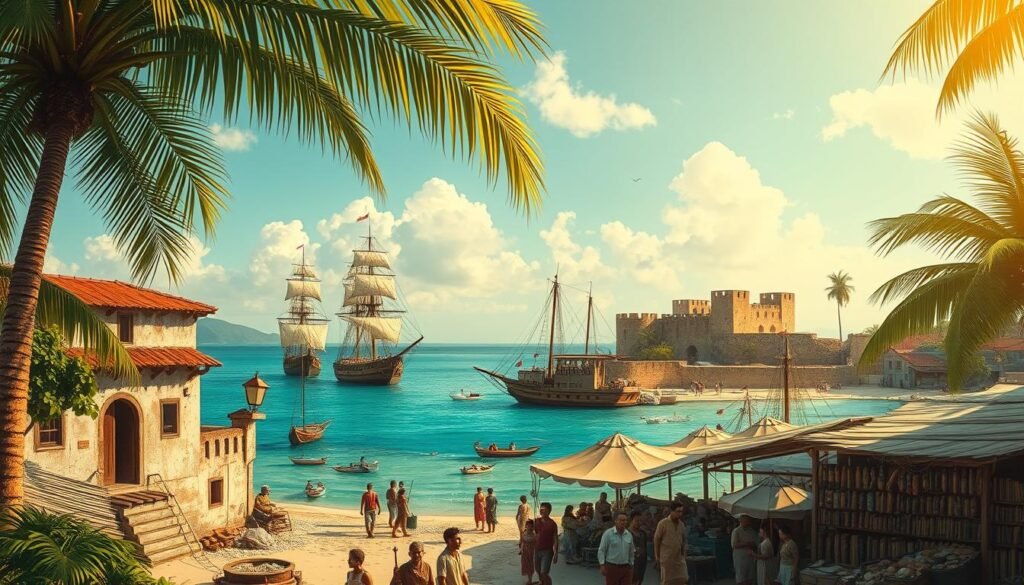
This article explores how these factors contributed to Bohol’s identity. By examining the economic and conflict-driven forces, we gain insight into the region’s past. The middle of the colonial period was particularly transformative, marking a turning point in its history.
Key terms like “trade” and “economic forces” are central to understanding this era. Trade routes brought goods and ideas, while economic pressures shaped local practices. These elements combined to create a unique historical narrative.
Below is a table summarizing key events and their impact on Bohol:
| Year | Event | Impact |
|---|---|---|
| 16th Century | Arrival of Spanish forces | Shift in political alliances |
| 17th Century | Expansion of trade networks | Economic growth and cultural exchange |
| 18th Century | Conflict with neighboring regions | Strengthening of local defenses |
This article will delve into these events from military, economic, and social angles. By understanding Bohol’s strategic past, we can better appreciate its role in Philippine history.
Historical Background of Slave Raiding
From Sumer to Southeast Asia, the capture of individuals was a common practice. This practice was deeply integrated into the system of ancient societies, serving both economic and political purposes. Early records from Sumer and Egypt highlight how this method was used to support labor needs and strengthen relations between communities.
In ancient Sumer, the capture of individuals was often tied to warfare. Captives were used as laborers to build infrastructure or work on agricultural land. Similarly, in Egypt, the practice was part of a broader system that supported the kingdom’s expansion and resource management.
Early Practices in Ancient Societies
Ancient societies relied on the capture of individuals to meet labor demands. In Sumer, captives were often used in construction projects, while in Egypt, they were employed in agriculture and mining. This practice was not just about labor but also about establishing dominance over neighboring areas.
Women, in particular, were often captured to serve in households or as part of diplomatic exchanges. This practice shaped the demographics of many regions, influencing the social and economic structures of ancient societies.
Medieval Developments in Southeast Asia
By the medieval period, the practice had evolved into a more organized system. In Southeast Asia, maritime powers like the Srivijaya Empire used the capture of individuals to support their trade networks. Captives were often sold in markets or exchanged for valuable resources.
This practice became a key part of the region’s economy, influencing both local and international trade. The capture of individuals was not just a method of acquiring labor but also a way to strengthen political alliances and control strategic areas.
| Period | Region | Key Practice |
|---|---|---|
| Ancient | Sumer, Egypt | Use of captives for labor and diplomacy |
| Medieval | Southeast Asia | Integration into trade networks and markets |
These historical practices highlight how the capture and trade of individuals shaped societies across different eras. By examining these developments, we gain insight into the complex relations between economics, politics, and social structures.
Slave Raiding: Its Tactics and Impact
Organized methods of capturing people shaped the dynamics of many societies. These practices were not random but involved systematic military operations. Settlements were often targeted through ambushes or large-scale raids, leaving communities vulnerable.
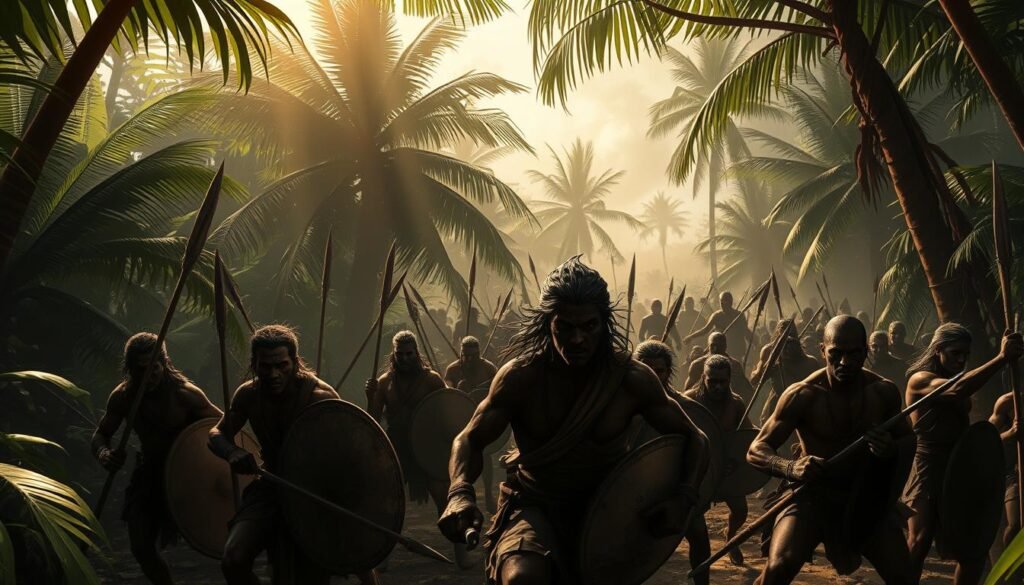
Transport mechanisms played a crucial role in these operations. Captured individuals were moved using ships, caravans, and other means. This allowed for the widespread distribution of labor and resources across regions.
Methods of Capturing and Transporting Slaves
Raids were carefully planned and executed. Military forces would often surround settlements, using force to subdue resistance. Once captured, individuals were transported under harsh conditions, often facing violence and deprivation.
- Ambushes were a common tactic, catching communities off guard.
- Large-scale raids involved coordinated efforts to maximize captives.
- Transport systems like ships and caravans facilitated long-distance movement.
The Role of Warfare and Economic Exploitation
These practices were deeply intertwined with warfare and economic strategies. Captured individuals were used as laborers, strengthening the economic power of those who controlled them. This exploitation was a key driver of many conflicts.
“The use of force in these operations left lasting scars on affected communities, including women and children.”
Over time, these practices evolved from accepted warfare tactics to criminal acts. Modern interpretations view them as violations of human rights, marking a significant shift in global perspectives.
For more insights into historical practices, explore this detailed analysis.
Bohol’s Alliance with Legazpi: A Strategic Overview
Strategic decisions often define the course of history, as seen in Bohol’s pact with Legazpi. This alliance was not just a diplomatic gesture but a calculated move to secure the island’s future. Political and military motivations drove this partnership, shaping the region’s trajectory.
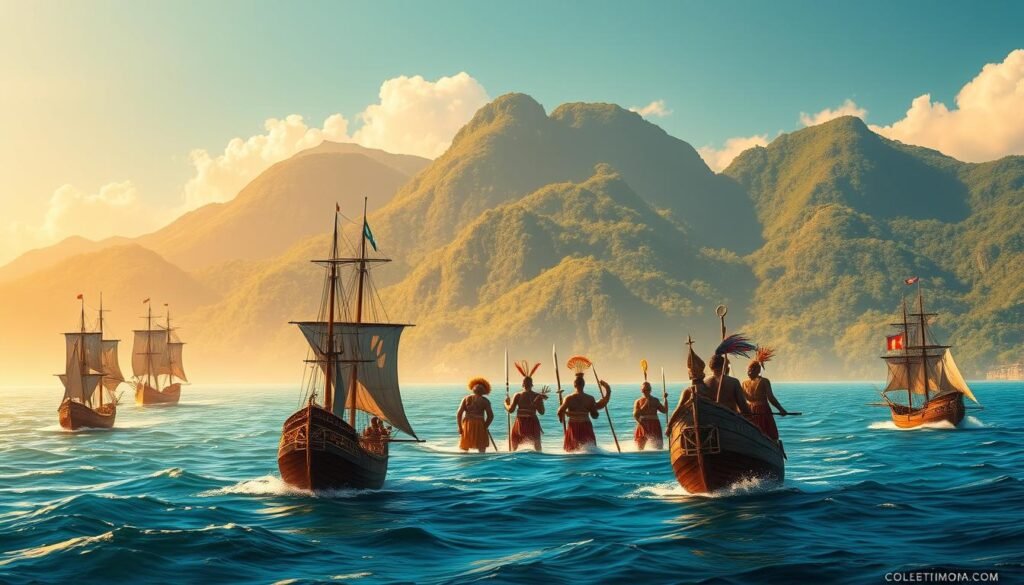
Political and Military Motivations Behind the Pact
The alliance was rooted in pragmatic considerations. Bohol’s leaders sought protection against rival forces that threatened their communities. By aligning with Legazpi, they gained a powerful ally to counter these threats.
Relations with European powers also played a significant role. The Spanish presence offered new opportunities for trade and military support. This influence shaped local strategies, ensuring Bohol’s leaders could navigate complex regional dynamics.
The role of the local army was crucial in this alliance. Integrated into broader military tactics, Bohol’s forces became a key component of the Spanish strategy. This collaboration strengthened both parties, creating a formidable partnership.
The impact on societal structures was profound. The alliance reshaped power dynamics, influencing how communities organized and defended themselves. This shift marked a turning point in Bohol’s history.
| Aspect | Impact |
|---|---|
| Political Alliances | Strengthened Bohol’s position against rivals |
| Military Integration | Enhanced local defense capabilities |
| European Influence | Shaped trade and strategic decisions |
| Societal Changes | Redefined power and community structures |
Economic and Trade Implications of the Slave Trade
Trade networks played a pivotal role in shaping the economies of Southeast Asia. These systems were not just about goods but also involved the movement of labor, which significantly influenced regional markets. The dynamics of resource exchange between local and colonial economies created a complex web of financial incentives.
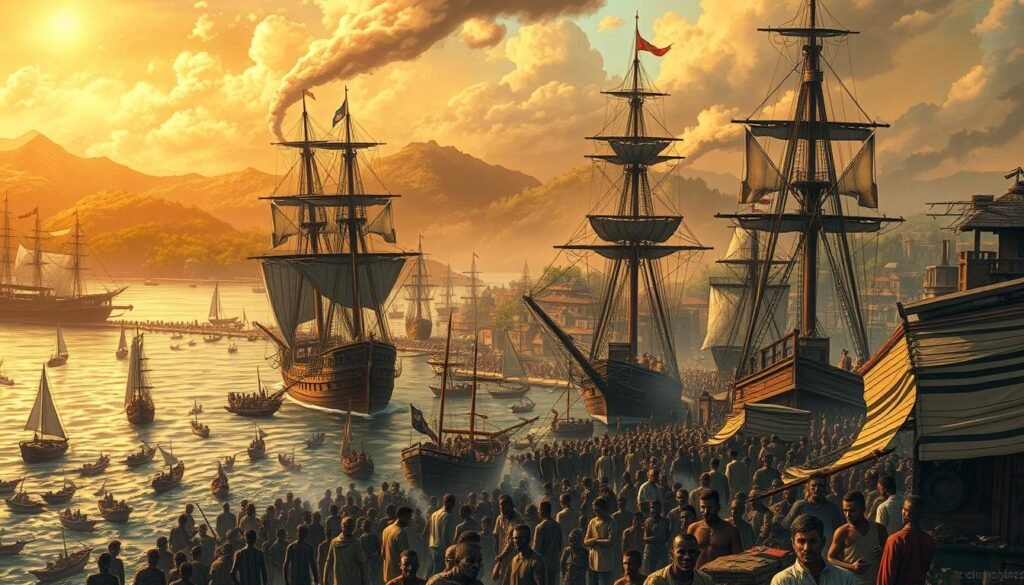
Historical practices altered traditional markets, boosting regional economies. The influx of labor reshaped local industries, creating new opportunities for growth. Financial incentives drove these operations, as traders sought to maximize profits through efficient resource allocation.
Market Dynamics and Resource Exchange
The market systems of the time responded to the demand for labor by expanding trade routes. This led to increased interactions between local and colonial economies. The exchange of resources, including labor, became a cornerstone of economic development.
Colonial expansion strategies relied heavily on these trade practices. By integrating local markets into broader networks, colonial powers strengthened their economic influence. This integration had long-term implications, shaping the region’s economic trajectory for centuries.
“The economic impact of these practices extended beyond immediate gains, influencing societal structures and regional stability.”
These historical trade practices highlight the interconnectedness of economics and politics. Understanding their impact provides insight into the broader forces that shaped Southeast Asia’s development.
Military Strategies Influenced by Raiding
Military strategies have always evolved in response to emerging threats. Over centuries, the need to defend against maritime attacks drove significant innovations in naval tactics and weaponry. These changes not only shaped the course of war but also influenced the development of maritime powers.
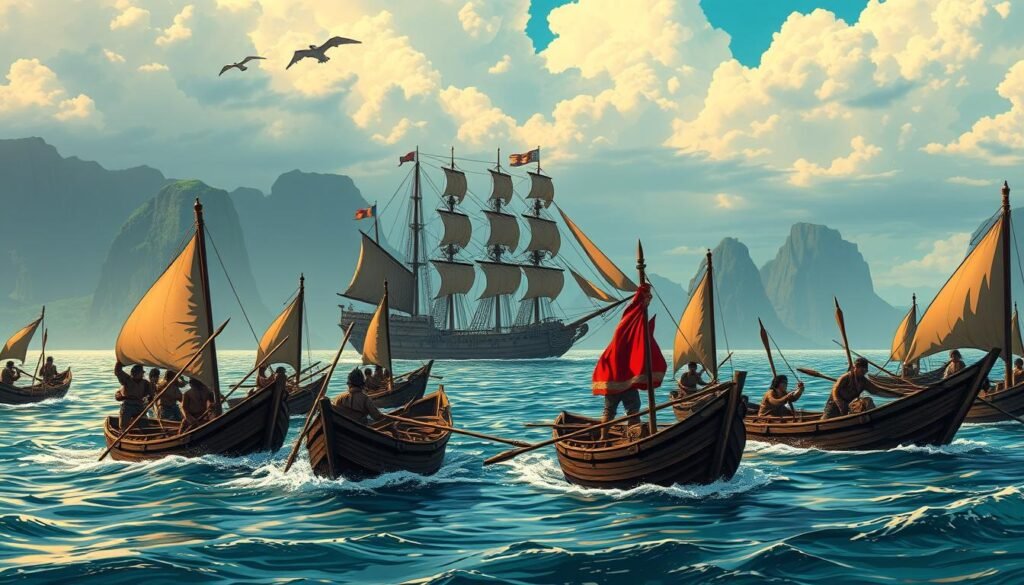
Maritime raids forced military forces to adapt quickly. Ships were redesigned to be faster and more maneuverable, allowing them to counter threats effectively. New weaponry, such as cannons and long-range firearms, became essential for both offense and defense.
Evolution of Naval Tactics and Weaponry
Naval tactics underwent a transformation as conflict intensified. Commanders developed strategies to outmaneuver attackers, such as flanking maneuvers and coordinated assaults. These tactics required precise communication and disciplined force.
One notable example is the use of smaller, faster ships to intercept raiders. This approach minimized losses and maximized efficiency. Additionally, advancements in navigation technology allowed fleets to operate more effectively in open waters.
| Period | Innovation | Impact |
|---|---|---|
| 16th Century | Introduction of cannons | Increased firepower and defensive capabilities |
| 17th Century | Development of faster ships | Improved interception and pursuit of raiders |
| 18th Century | Advancements in navigation | Enhanced strategic planning and deployment |
These innovations highlight the dynamic nature of military strategy. By adapting to new challenges, naval forces not only defended their territories but also expanded their influence. This evolution remains a testament to the resilience and ingenuity of maritime powers.
Cultural and Societal Shifts in Bohol
The cultural landscape of Bohol underwent profound changes due to external pressures. These shifts reshaped the society and left a lasting impact on indigenous communities. The population dynamics were altered, affecting family units and traditional roles.

Indigenous social structures faced significant challenges. The loss of individuals disrupted the balance within villages, leading to changes in leadership and community roles. Families were particularly affected, as the absence of a person often meant the loss of a provider or caregiver.
Impact on Indigenous Communities and Social Structures
Demographic changes were one of the most visible effects. The population in many villages declined, altering the social fabric. This decline impacted the roles of women and children, who often had to take on additional responsibilities.
Traditional practices were also transformed. External influences introduced new customs, leading to the erosion of indigenous traditions. This cultural loss affected the identity of Bohol’s communities, as they struggled to preserve their heritage.
| Aspect | Impact |
|---|---|
| Population Decline | Reduced community size and altered demographics |
| Family Structures | Increased responsibilities for women and children |
| Cultural Practices | Erosion of traditional customs and identity |
| Community Roles | Shift in leadership and social responsibilities |
These changes had long-term ramifications. Indigenous communities in Bohol demonstrated resilience, adapting to new realities while striving to maintain their cultural identity. Understanding these shifts provides insight into the broader impact of historical events on Philippine society.
The Role of Maritime Raiding in Philippine History
From piracy to organized warfare, the seas of the Philippines witnessed significant transformations. These maritime activities played a crucial role in shaping the region’s history, influencing both colonization and resistance tactics. The eastern parts of the archipelago, in particular, became a focal point for these strategies.
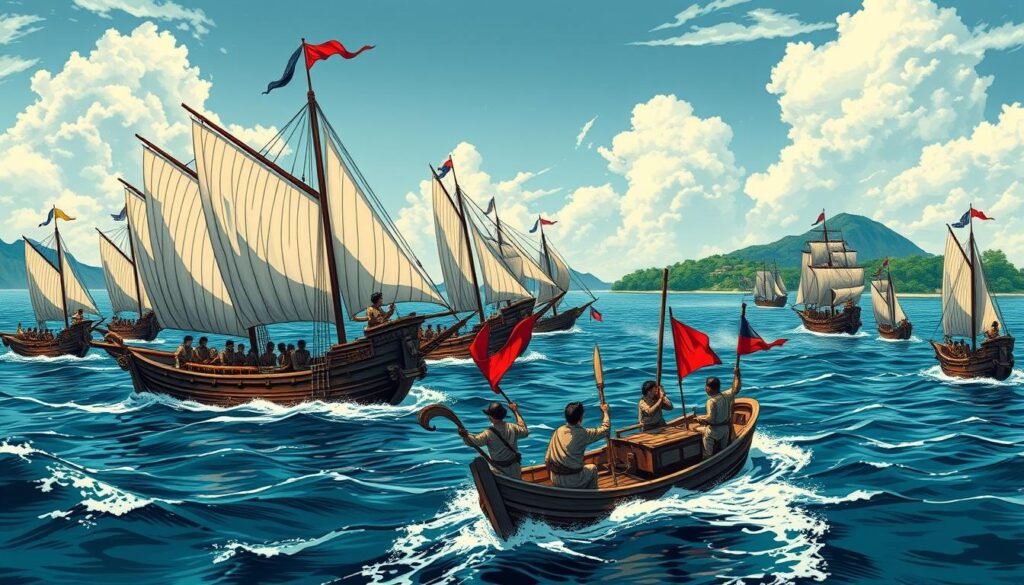
Early maritime practices in the Philippines were often disorganized, with piracy being a common occurrence. Over time, these activities evolved into more structured military operations. This shift was driven by the need to control trade routes and secure territorial dominance.
From Piracy to Organized Warfare
The transition from piracy to organized warfare marked a turning point in Philippine history. Raids were no longer random acts but carefully planned military campaigns. This change was influenced by the growing presence of colonial powers in the region.
For example, the Balangingi Samal raiders of the Sulu-Mindanao region specialized in state-sanctioned maritime activities. Their operations disrupted inter-island trade and challenged colonial forces. This evolution reflects the broader dynamics of the eastern archipelago during that period.
“The shift from piracy to organized warfare reshaped the political and economic landscape of the Philippines.”
The impact of these practices extended beyond immediate conflicts. They influenced the strategies of both local leaders and colonial administrators. The history of maritime raiding provides valuable insights into the region’s development.
| Period | Key Development | Impact |
|---|---|---|
| 16th Century | Rise of piracy | Disruption of trade routes |
| 17th Century | Transition to organized warfare | Strengthening of local defenses |
| 19th Century | State-sanctioned maritime activities | Challenges to colonial rule |
These developments highlight the complex interplay between maritime strategies and regional history. Understanding this evolution helps us appreciate the resilience and adaptability of Philippine communities.
Religious and Ideological Dimensions of Raiding
Religious beliefs often shaped the strategies and outcomes of historical conflicts. In many cases, ideology served as both a justification and a condemnation for certain practices. This was particularly evident in the interactions between Muslim communities and European colonizers, where religious arguments were frequently used to legitimize actions.

Muslim communities were often both perpetrators and victims of these tactics. On one hand, they defended their territories using religious rhetoric. On the other, they faced exploitation and displacement by colonial powers who framed their actions as part of a divine mission.
Colonial powers frequently used religious arguments to justify their actions. They portrayed their campaigns as efforts to spread Christianity or civilize “heathen” populations. This ideological framing allowed them to gain support from their home countries while undermining local resistance.
“The use of religion as a tool for legitimization reshaped the dynamics of power and resistance in many regions.”
The broader ideological conflict between traditional state systems and emerging colonial orders was significant. Traditional societies often relied on established social and religious structures to maintain order. In contrast, colonial powers introduced new systems that disrupted these structures, leading to widespread societal changes.
Specific instances highlight how religious beliefs influenced raiding practices. For example, in Southeast Asia, the integration of religious ideology into maritime strategies shaped both local and colonial approaches to conflict. These practices had lasting impacts on the region’s development.
| Aspect | Impact |
|---|---|
| Religious Justification | Legitimized colonial actions and suppressed local resistance |
| Muslim Communities | Played dual roles as defenders and victims |
| Ideological Conflict | Disrupted traditional state systems and introduced colonial orders |
| Historical Practices | Shaped regional development and societal structures |
Understanding these dimensions provides insight into the complex interplay between religion, ideology, and power. For a deeper exploration of historical slavery systems, visit this detailed analysis.
Comparative Perspectives: European vs. Asian Slave Raiding
European and Asian approaches to historical practices reveal stark contrasts in strategy and intent. While both regions engaged in similar activities, their motivations and methods were shaped by distinct cultural, political, and economic factors. This section explores these differences, offering insights into how these practices influenced regional development.
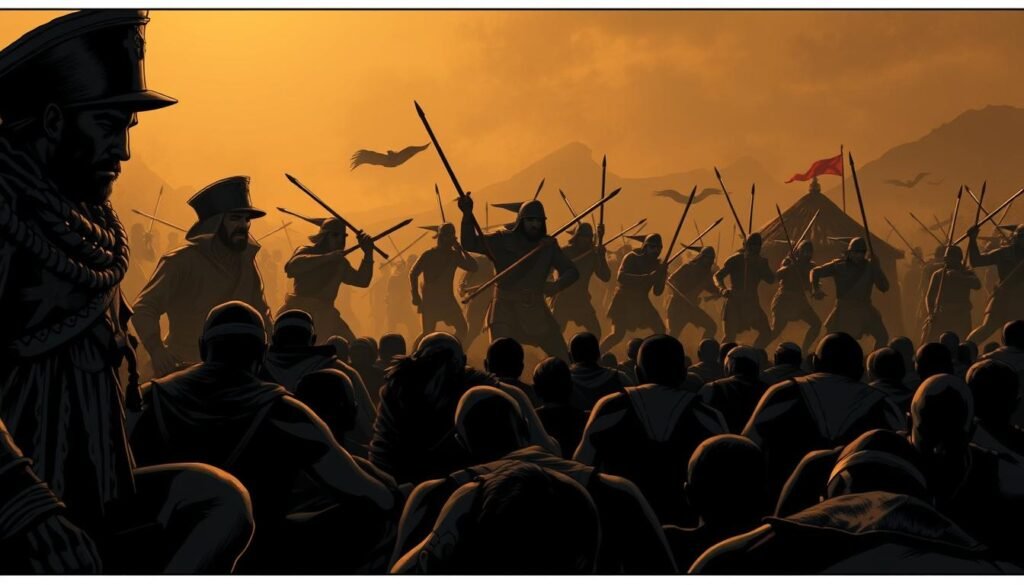
Differences in Strategies and Motivations
European practices were often driven by colonial expansion and economic exploitation. For example, the VOC (Dutch East India Company) imported hundreds of thousands of individuals to support their settlements. This approach was rooted in the need for labor to sustain colonial economies.
In contrast, Asian practices were more integrated into local power structures. The Ottoman Empire, for instance, used systematic methods to incorporate individuals into their military ranks. This strategy was not just about labor but also about strengthening their state systems.
“The VOC’s reliance on treaties and agreements highlights the bureaucratic nature of European practices, while the Ottoman method reflects a more militarized approach.”
Military, Economic, and Political Strategies
European strategies often involved formal agreements and treaties. The Bungaya treaty of 1667, for example, required the Makassar Empire to yield 1,000 individuals as a consequence of breaking the peace. This formalized approach contrasts with Asian methods, which were more decentralized and tied to local conflict dynamics.
Economic motivations also differed. European powers sought to maximize profits through efficient resource allocation, while Asian practices were often tied to regional trade networks and cultural exchanges.
| Aspect | European Practices | Asian Practices |
|---|---|---|
| Motivation | Economic exploitation and colonial expansion | Strengthening state systems and military power |
| Methods | Formal treaties and agreements | Decentralized and integrated into local systems |
| Impact | Shaped colonial economies | Influenced regional trade and cultural dynamics |
These differences highlight the unique ways in which European and Asian practices shaped their respective regions. By understanding these contrasts, we gain a deeper appreciation for the complexities of historical development.
Impact on Colonial Administration and Governance
Colonial administrations faced significant challenges in maintaining control due to persistent unrest. Repeated disruptions forced them to adapt their governance systems to secure their territories. These adaptations reshaped the state structures and influenced the balance of power in the region.
One of the key measures taken was the integration of local armies into colonial operations. This strategy not only strengthened their military capabilities but also fostered a complex relation between colonizers and indigenous populations. The collaboration often came with tensions, as local leaders sought to protect their communities while aligning with colonial interests.
Specific instances highlight how these disruptions impacted administrative policies. For example, in the Philippines, the Spanish colonial government implemented stricter controls over coastal areas to prevent further disturbances. These measures included increased patrols and the establishment of fortified settlements.
The evolving dynamics between colonizers and indigenous populations also played a crucial role. As colonial administrations sought to maintain order, they often had to negotiate with local leaders. This negotiation process sometimes led to compromises that reshaped governance structures.
For a deeper understanding of how historical practices influenced governance, explore this detailed analysis.
In summary, the challenges posed by persistent unrest forced colonial administrations to adapt their strategies. These adaptations not only secured their territories but also reshaped the political and social landscape of the region.
Enduring Legacy of Slave Raiding in Regional History
The echoes of historical practices continue to shape regional narratives in profound ways. The legacy of these events influences not only our understanding of the past but also the structures of modern societies. From economic systems to cultural memory, the impact of historical practices remains deeply embedded in regional history.
One of the most significant long-term effects is the transformation of economic systems. The dynamics of historical trade networks have left a lasting mark on modern market practices. For example, the redistribution of labor and resources during the colonial period continues to influence economic relationships in the region.
The legacy of war and conflict also plays a crucial role in shaping present-day relations. Historical practices have created patterns of mistrust and cooperation that persist in contemporary interactions. These patterns are evident in the way communities navigate political and social challenges today.
“The enduring impact of historical practices highlights the interconnectedness of past and present, offering valuable lessons for modern societies.”
Cultural memory is another area where the legacy of historical practices is evident. Stories and traditions passed down through generations reflect the experiences of those who lived through these events. This cultural continuity provides a unique lens through which to view regional history.
Current research continues to explore the implications of these historical patterns. Scholars are uncovering new insights into how past practices influence modern systems. For example, studies on the economic impact of historical trade networks reveal their role in shaping regional development.
To delve deeper into the economic consequences of historical practices, explore this detailed analysis.
In summary, the legacy of historical practices is a testament to their enduring influence. By understanding these connections, we gain valuable insights into the complexities of regional history and its modern implications.
Reassessing Historical Narratives in a Modern Context
Modern scholarship is increasingly challenging long-held views on historical practices. As new research emerges, traditional narratives are being reevaluated to provide a more nuanced understanding of the past. This reassessment is particularly relevant when examining complex issues that have shaped regional development.
Historical interpretations are subject to continuous debate due to evolving methodologies and discoveries. Recent archaeological findings, for example, have shed light on previously overlooked aspects of colonial practices. These insights are reshaping how we view specific periods in history.
New Interpretations and Debates
One of the key debates centers on the motivations behind historical practices. Traditional narratives often emphasized economic exploitation, but new perspectives highlight the role of political and cultural factors. This shift in focus is transforming our understanding of past events.
Recent studies have also emphasized the importance of local contexts. By examining regional variations, scholars are uncovering patterns that challenge conventional narratives. This approach is particularly valuable in reassessing the impact of colonial practices on indigenous communities.
“The reinterpretation of historical events is not just an academic exercise but a means to better understand the complexities of our past.”
Modern methodologies, such as digital archaeology and data analysis, are playing a crucial role in this reassessment. These tools allow researchers to analyze large datasets and uncover trends that were previously invisible. As a result, our understanding of history is becoming more comprehensive and accurate.
| Period | Traditional Narrative | Modern Interpretation |
|---|---|---|
| 16th Century | Economic exploitation | Political and cultural motivations |
| 17th Century | Colonial dominance | Local resistance and adaptation |
| 18th Century | Uniform practices | Regional variations and complexities |
The evolving discourse on historical practices underscores the importance of revisiting established narratives. By integrating new research and perspectives, scholars are providing a more balanced view of the past. This approach not only enriches our understanding of history but also informs contemporary discussions on related issues.
For a deeper exploration of these themes, refer to this detailed analysis on the global history of slavery.
Lessons Learned from Historical Slave Raiding
Historical events often leave behind lessons that shape future decisions. Examining the strategies and impacts of past practices provides valuable insights into human behavior and governance. These lessons are particularly relevant when analyzing the exploitation of human resources and their long-term effects on societies.
One key lesson is the importance of understanding the ethical implications of such practices. Historical accounts reveal how the exploitation of individuals reshaped societal structures. For example, the demographic decline in affected areas often forced women and children into roles previously held by men. This shift highlights the far-reaching consequences of these actions.
Another critical takeaway is the role of military strategies in these practices. Organized campaigns often relied on systematic methods to achieve their goals. These tactics not only disrupted communities but also influenced the development of statecraft and governance systems.
“The lessons of history remind us that the exploitation of human resources leaves a lasting impact on societies, shaping their future trajectories.”
Understanding these past errors is essential for informing future policies. By examining how historical practices altered economic and social systems, we can avoid repeating similar mistakes. This approach is particularly relevant in discussions about modern governance and ethical decision-making.
The moral and ethical implications of these practices continue to resonate today. They serve as cautionary tales, reminding us of the importance of respecting human dignity and rights. These lessons are not just historical footnotes but guiding principles for contemporary societies.
| Lesson | Impact |
|---|---|
| Ethical Implications | Reshaped societal structures and roles |
| Military Strategies | Influenced statecraft and governance |
| Resource Exploitation | Altered economic and social systems |
| Moral Lessons | Serve as cautionary tales for modern governance |
In summary, the lessons learned from historical practices offer valuable insights into the complexities of human behavior and governance. By understanding these patterns, we can make informed decisions that respect human dignity and promote ethical practices.
Future Implications for Philippine Historical Studies
Understanding the past is key to shaping the future of Philippine historical studies. The lessons learned from historical events can guide future academic inquiry and policy-making. By examining the impact of these events, researchers can uncover new insights into the country’s development.
New research has the potential to transform our understanding of the economic and social changes that occurred during this period. For example, studies on trade networks and governance systems can reveal how historical practices influenced modern structures. This knowledge is crucial for addressing contemporary challenges.
Historical strategy and operation practices also offer valuable lessons for governance. By analyzing how past leaders navigated complex situations, policymakers can develop more effective approaches. This interdisciplinary research can blend history, economics, and political science to provide a comprehensive view.
Global historical trends also play a role in shaping local studies. The Philippines’ unique position in the world makes it a focal point for understanding broader patterns. By connecting local events to global movements, scholars can provide a richer context for Philippine history.
“The study of history is not just about the past; it’s about informing the future and creating a better understanding of our world.”
For a deeper exploration of Philippine history, visit this detailed analysis. Understanding these legacies is essential for future academic debates and policy decisions. By learning from the past, we can build a more informed and resilient future.
Conclusion
The historical events in Bohol reveal a complex interplay of alliances and conflicts. These practices, deeply rooted in the region’s past, shaped its relationship with Legazpi and the Spanish. Over time, they evolved from localized strategies to broader systems that influenced socio-economic structures.
The lasting effects of war and violence are evident in the disruptions they caused. Communities faced demographic shifts, altering family roles and societal dynamics. These changes continue to resonate in modern narratives, highlighting the enduring impact of historical practices.
Understanding these events provides insight into broader themes in Philippine history. They reveal how alliances and conflicts shaped regional identities and governance. Reflecting on these lessons encourages further research into their implications for contemporary issues.
FAQ
What were the early practices of capturing people in ancient societies?
In ancient societies, capturing individuals often involved warfare and conflicts. These practices were used to gain labor, resources, or political power, shaping early systems of exploitation.
How did medieval developments in Southeast Asia influence raiding tactics?
During the medieval period, Southeast Asia saw the rise of organized maritime operations. These tactics were driven by economic needs and the desire to control trade routes, leading to more systematic methods of capturing and transporting captives.
What role did warfare play in the economic exploitation of captured individuals?
Warfare was a key tool for economic exploitation, as it allowed powerful groups to seize resources and labor. Captives were often traded or used to strengthen military and economic systems.
Why did Bohol form an alliance with Legazpi and the Spanish?
Bohol’s alliance with Legazpi was driven by political and military motivations. The pact provided protection against rival groups and secured Spanish support in regional conflicts.
How did the exchange of resources shape market dynamics during this period?
The exchange of resources, including captives, created a complex market system. This trade influenced local economies and strengthened ties between different regions and cultures.
What impact did raiding have on naval tactics and weaponry?
Raiding led to the evolution of naval tactics and weaponry, as groups developed new strategies to defend against or conduct maritime operations. This innovation shaped military practices in the region.
How did raiding affect indigenous communities and social structures in Bohol?
Raiding disrupted indigenous communities, altering social structures and cultural practices. It forced adaptations in governance, resource management, and community relations.
What were the differences between European and Asian raiding strategies?
European and Asian raiding strategies differed in motivations and methods. Europeans often focused on colonial expansion, while Asian groups prioritized regional dominance and resource control.
How did raiding influence colonial administration and governance?
Raiding shaped colonial administration by forcing authorities to address security concerns and manage resource distribution. It also influenced policies on trade and local governance.
What is the enduring legacy of raiding in regional history?
The legacy of raiding is seen in cultural narratives, economic systems, and historical conflicts. It continues to influence modern interpretations of regional history and identity.
Source Links
- The Philippine Islands, 1493-1898 — Volume 12 of 55 1601-1604 Explorations by Early Navigators, Descriptions of the Islands and Their Peoples, Their History and Records of the Catholic Missions, as Related in Contemporaneous Books and Manuscripts, Showing the Political, Economic, Commercial
- Magellan: The World of the Visayas | Danilo Madrid Gerona
- The Philippines Past and Present
- The History of Palawan: Stories of the Past – Richest Philippines
- Slave raiding
- Slavery – Transatlantic, Abolition, Trafficking | Britannica
- Digital History
- The Sulu Sea (Chapter 2) – Pirates of Empire
- Nunn.dvi
- History of slavery
- Bohol
- Understanding the long-run effects of Africa’s slave trades
- Roles played by leaders of African societies – Implications of the slave trade for African societies – Higher History Revision – BBC Bitesize
- Slave-Raiding, Solidarity and Status in Africa
- Slavery and the “American Way of War,” 1607–1861 | Comparative Studies in Society and History | Cambridge Core
- bohol island philippines: Topics by Science.gov
- Slaving and the Global Reach of the Moro Wars in the Seventeenth Century
- The Diversity and Reach of the Manila Slave Market (Chapter 2) – Asian Slaves in Colonial Mexico
- Iranun and Balangingi: globalization, maritime raiding and the birth of ethnicity. (Research Notes) – Document
- African Slavery versus the Slave Trade(s) (Chapter 2) – Slavery, Resistance, and Identity in Early Modern West Africa
- Why did doctrinal religions first appear in the Northern Subtropical Zone?
- Project MUSE – Slaving, Colonial Diplomacy, and Resource Extraction in Seventeenth-Century Maritime Asia
- Global Slavery in the Making of States and International Orders | American Political Science Review | Cambridge Core
- The Transatlantic Slave Trade | Equal Justice Initiative
- The Story of Africa| BBC World Service
- The legacies of slavery in and out of Africa – IZA Journal of Development and Migration
- The Enduring Impacts of Slavery: A Historical Perspective on South–South Migration
- Counterfactual Narratives of the Civil War and Slavery | Journal of American Studies | Cambridge Core
- Atlantic slave trade
- The Transatlantic Slave Trade – The Metropolitan Museum of Art
- Slavery – African, Colonial, Abolition | Britannica
- English Trade in Deerskins and Enslaved Indians – New Georgia Encyclopedia

